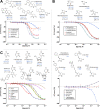Sweet and Blind Spots in E3 Ligase Ligand Space Revealed by a Thermophoresis-Based Assay
- PMID: 33488967
- PMCID: PMC7812675
- DOI: 10.1021/acsmedchemlett.0c00440
Sweet and Blind Spots in E3 Ligase Ligand Space Revealed by a Thermophoresis-Based Assay
Erratum in
-
Correction to "Sweet and Blind Spots in E3 Ligase Ligand Space Revealed by a Thermophoresis-Based Assay".ACS Med Chem Lett. 2021 Dec 28;13(1):148-149. doi: 10.1021/acsmedchemlett.1c00693. eCollection 2022 Jan 13. ACS Med Chem Lett. 2021. PMID: 35047112 Free PMC article.
Abstract
Repurposing E3 ubiquitin ligases for targeted protein degradation via customized molecular glues or proteolysis-targeting chimeras (PROTACs) is an increasingly important therapeutic modality. Currently, a major limitation in the design of suitable molecular glues and PROTACs is our fragmentary understanding of E3 ligases and their ligand space. We here describe a quantitative assay for the discovery and characterization of E3 ligase ligands that is based on the thermophoretic behavior of a custom reporter ligand. Thereby, it is orthogonal to commonly employed fluorescence-based assays and less affected by the optical properties of test compounds. It can be employed for the high-throughput screening of compound libraries for a given ligase but also for hit validation, which we demonstrate with the identification of unexpected well-binders and non-binders, yielding new insights into the ligand space of cereblon (CRBN).
© 2020 American Chemical Society.
Conflict of interest statement
The authors declare no competing financial interest.
Figures





Similar articles
-
High throughput E3 ligase degron binding assays for novel PROTAC ligand discovery.Methods Enzymol. 2023;681:23-39. doi: 10.1016/bs.mie.2022.08.027. Epub 2022 Sep 23. Methods Enzymol. 2023. PMID: 36764759
-
Design, synthesis and biological evaluation of the tumor hypoxia-activated PROTACs bearing caged CRBN E3 ligase ligands.Bioorg Med Chem. 2023 Mar 15;82:117237. doi: 10.1016/j.bmc.2023.117237. Epub 2023 Mar 8. Bioorg Med Chem. 2023. PMID: 36906965
-
Cereblon target validation using a covalent inhibitor of neosubstrate recruitment.Methods Enzymol. 2023;681:155-167. doi: 10.1016/bs.mie.2022.08.056. Epub 2022 Dec 30. Methods Enzymol. 2023. PMID: 36764755
-
E3 ligase ligand optimization of Clinical PROTACs.Front Chem. 2023 Jan 17;11:1098331. doi: 10.3389/fchem.2023.1098331. eCollection 2023. Front Chem. 2023. PMID: 36733714 Free PMC article. Review.
-
E3 ligase ligand chemistries: from building blocks to protein degraders.Chem Soc Rev. 2022 May 10;51(9):3487-3534. doi: 10.1039/d2cs00148a. Chem Soc Rev. 2022. PMID: 35393989 Review.
Cited by
-
Replacing the phthalimide core in thalidomide with benzotriazole.J Enzyme Inhib Med Chem. 2022 Dec;37(1):527-530. doi: 10.1080/14756366.2021.2024525. J Enzyme Inhib Med Chem. 2022. PMID: 35220840 Free PMC article.
-
Leveraging Ligand Affinity and Properties: Discovery of Novel Benzamide-Type Cereblon Binders for the Design of PROTACs.J Med Chem. 2023 Nov 9;66(21):14513-14543. doi: 10.1021/acs.jmedchem.3c00851. Epub 2023 Oct 30. J Med Chem. 2023. PMID: 37902300 Free PMC article.
-
High-resolution structures of the bound effectors avadomide (CC-122) and iberdomide (CC-220) highlight advantages and limitations of the MsCI4 soaking system.Acta Crystallogr D Struct Biol. 2022 Mar 1;78(Pt 3):290-298. doi: 10.1107/S2059798322000092. Epub 2022 Feb 18. Acta Crystallogr D Struct Biol. 2022. PMID: 35234143 Free PMC article.
-
On the correlation of cereblon binding, fluorination and antiangiogenic properties of immunomodulatory drugs.Biochem Biophys Res Commun. 2021 Jan 1;534:67-72. doi: 10.1016/j.bbrc.2020.11.117. Epub 2020 Dec 10. Biochem Biophys Res Commun. 2021. PMID: 33310190 Free PMC article.
-
Thalidomide-induced limb malformations: an update and reevaluation.Arch Toxicol. 2025 May;99(5):1643-1747. doi: 10.1007/s00204-024-03930-z. Epub 2025 Apr 8. Arch Toxicol. 2025. PMID: 40198353 Review.
References
LinkOut - more resources
Full Text Sources
Other Literature Sources
Chemical Information

